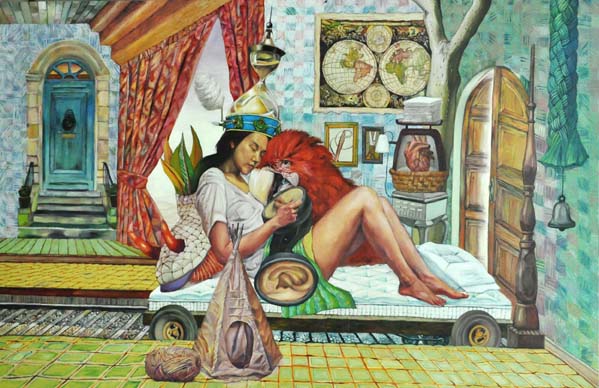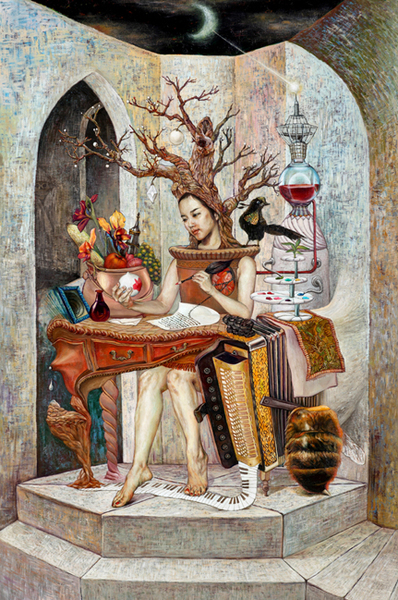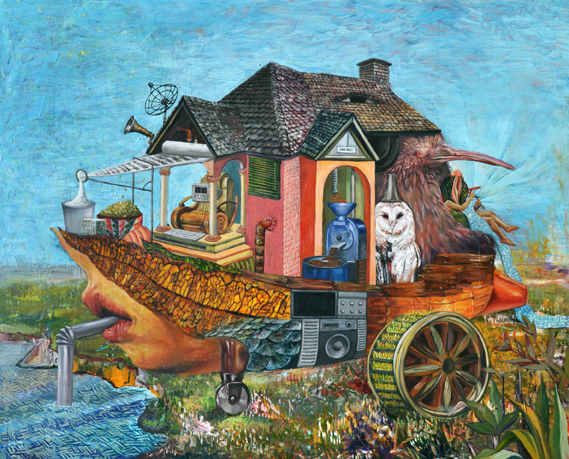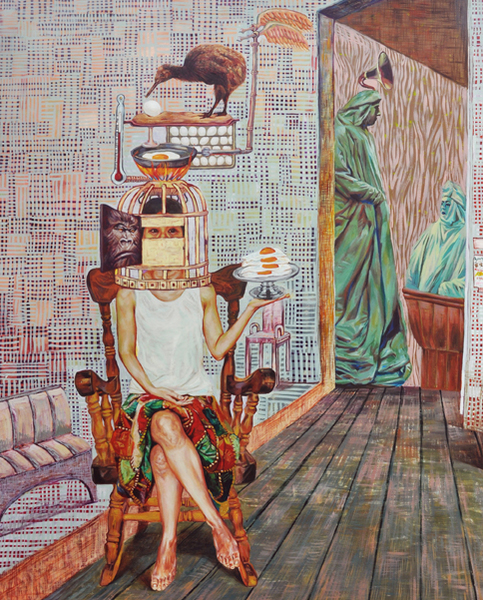Works 2009-12
Travelling House
2011
oil on canvas
64 x 51 in inches (162 x 130cm)
2011
oil on canvas
64 x 51 in inches (162 x 130cm)
To convey the urban nomad’s desire for a base and to present a negotiated middle ground that satisfies both their realities and ideals.
I experienced a countless number of relocations as a result of being confronted by a variety of circumstances that dynamically arose in my life. Given thus, I find myself grasping at the personalized connotative power of the term, “home“ -- especially in Seoul, a city characterized by its exceeding pace of change -- to mean an ever-changing and ephemeral locale or entity for respite.
The walls are cold to the touch in spite of the building’s foundation being deeply rooted in the earth. And while I may litter the space with my messages, photographs and belongings, I find myself oft rebuked by the sense that this space cannot contain my history nor can it provide feelings of security that are associated with the notion of settlement. This is because, somewhere permanently deep in my heart resides the understanding that I must ready myself for the pending migration.
Vanishing are places of Rest, spaces where I can remind myself of what it means to be me.
We are observed by media outlets and bombarded with information; these transmissions remain uninterrupted even during my sleep via mobile devices. In our urban settings, these waves of information continue to crash down and berate us without allowing for any realistic opportunity to discern its value. Perhaps it is possible that we, in these urban settings, have already lost our reason to search for some semblance of identity, to ascertain a sense of “me.”
While attempts to verbalize or visualize the following may risk a certain level of vagueness, in our hearts somewhere, there exists a space of nostalgia that does not change. This space serves as an inner locale for intermission that can be revisited.
Through my work, I sought to construct for them, the “me’s,” a structural representation of their own nostalgia of “me.” Though my work lacks the technical direction of a doctor’s dissertation, I strived to manifest the indirect connections that exist between the floating sentiments that comprise them “me’s” heart’s desires and to illustrate that forms of satisfaction and recognizable security can and do exist beyond those connective barriers.This House, which draws its locomotive properties from new compounds that are created by combining the components that are subjectively extracted from the surrounding environment, is a space capable of manufacturing an aggregation of one’s consciousness by recognizing the intangible Ego’s immediate sentiments.
The House then proceeds to export this manufactured aggregation of consciousness to the outer world, thereby functioning as a house of “Value.”
It is a space for the representation of me. It serves as a historical archive of myself.
In the fast-paced environment of change that is urban dwelling, this House remains unaffected and unrevised as it preserves the sense of self-identity that has been accumulated. Most of all, it is a very personal space.
Furthermore, the House is a capable space as it is always able to connect to the outer world.
This House is for “me” and for “us.” This House is both “mine” and “ours.” This House, unfettered by time or circumstance, is able to put down its roots whenever which empowers it to be both a house of settlement and a base for nomads.
I experienced a countless number of relocations as a result of being confronted by a variety of circumstances that dynamically arose in my life. Given thus, I find myself grasping at the personalized connotative power of the term, “home“ -- especially in Seoul, a city characterized by its exceeding pace of change -- to mean an ever-changing and ephemeral locale or entity for respite.
The walls are cold to the touch in spite of the building’s foundation being deeply rooted in the earth. And while I may litter the space with my messages, photographs and belongings, I find myself oft rebuked by the sense that this space cannot contain my history nor can it provide feelings of security that are associated with the notion of settlement. This is because, somewhere permanently deep in my heart resides the understanding that I must ready myself for the pending migration.
Vanishing are places of Rest, spaces where I can remind myself of what it means to be me.
We are observed by media outlets and bombarded with information; these transmissions remain uninterrupted even during my sleep via mobile devices. In our urban settings, these waves of information continue to crash down and berate us without allowing for any realistic opportunity to discern its value. Perhaps it is possible that we, in these urban settings, have already lost our reason to search for some semblance of identity, to ascertain a sense of “me.”
While attempts to verbalize or visualize the following may risk a certain level of vagueness, in our hearts somewhere, there exists a space of nostalgia that does not change. This space serves as an inner locale for intermission that can be revisited.
Through my work, I sought to construct for them, the “me’s,” a structural representation of their own nostalgia of “me.” Though my work lacks the technical direction of a doctor’s dissertation, I strived to manifest the indirect connections that exist between the floating sentiments that comprise them “me’s” heart’s desires and to illustrate that forms of satisfaction and recognizable security can and do exist beyond those connective barriers.This House, which draws its locomotive properties from new compounds that are created by combining the components that are subjectively extracted from the surrounding environment, is a space capable of manufacturing an aggregation of one’s consciousness by recognizing the intangible Ego’s immediate sentiments.
The House then proceeds to export this manufactured aggregation of consciousness to the outer world, thereby functioning as a house of “Value.”
It is a space for the representation of me. It serves as a historical archive of myself.
In the fast-paced environment of change that is urban dwelling, this House remains unaffected and unrevised as it preserves the sense of self-identity that has been accumulated. Most of all, it is a very personal space.
Furthermore, the House is a capable space as it is always able to connect to the outer world.
This House is for “me” and for “us.” This House is both “mine” and “ours.” This House, unfettered by time or circumstance, is able to put down its roots whenever which empowers it to be both a house of settlement and a base for nomads.







![Process[W-ray] SAWOOL KIM Works 2009-12 oil on canvas](http://d3zr9vspdnjxi.cloudfront.net/artistInfo/sawoolki/thumb/665.jpg?1390181617)


